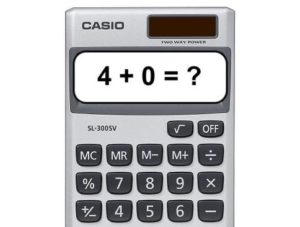
Should Calculators Be Allowed in Math Class?
Do they improve the classroom experience or interfere with learning? Here’s how to decide if calculators should be allowed in your math class.

I was mid-way through my teaching career before I began teaching math. My co-workers didn’t see themselves as “math people,” so it was only a matter of time before my principal asked me to switch over from English.
Not having paid much attention to middle school math in the past two decades, I figured “How hard could it be?” I imagined myself teaching some fractions and maybe how to find the area of a rectangle. When I actually opened the textbook, I was shocked to find that the first unit covered complex multi-step word problems. My students would have multiply and divide decimals. Many of the questions required, not only computation, but the ability to set up equations involving rates and unknown values.
During the first week of classes, I gave students the diagnostic test from the text, and not one student passed. The tests were meant to cover elementary math standards. I saw that many of my students struggled with topics like rounding whole numbers and two-digit addition. The good news was that I had gathered some interesting data. The problem, however, was that I had no way to use it.
It can be challenging to use grades to inform instruction. There are many reasons why grades aren’t the best data. Not only are they subjective, but they rarely measure what we really need to know.
I’ve gotten some pushback from math teachers by calling math grades subjective. “We’re not grading papers – each question is either right or wrong.” And there is truth to that.
On the other hand, we all know how inconsistent grades can be from one class to another. When I saw how my students struggled with concepts from prior grades, I wondered what had happened the previous year. I checked their transcripts and found that most had been earning straight A’s year after year. What was going on?
The reality is that most grades have little to do with grade-level proficiency. A typical grading system is a hodgepodge of data points. Homework completion, test scores, “participation,” bonus points, and so on. In most schools there is pressure to keep grades high. Failing grades invite scrutiny from parents and administrators. Over the years, I’d learned to construct my grading system to allow for mostly A’s and a few B’s. Students who wanted a C in my class really had to go out of their way to earn one.
As a reaction to “grade inflation,” some schools have adopted standards-based grading. The idea is that every teacher uses the same tests, and the tests determine the grades. This approach is designed to make grades more objective, but does it lead to better teaching?
On the whole, I’m not convinced that SBG produces better outcomes. While it may be better for “rating and sorting” students, it can actually prevent teachers from meeting student needs. I’m a big believer that students need to feel that success is within reach. When I taught students who struggled, I did everything possible to give them a path to success. If a student works hard and makes progress, but is still behind grade level, what’s the benefit of giving them a low grade?
I’m also concerned that measuring students against grade level doesn’t help us target instruction. I recently wrote about the importance of assessing proficiency on a sliding scale. It’s not terribly helpful just to know that a 7th grade student is not proficient on grade level standards. It’s very helpful to know that a 7th grade student is proficient through grade 4 operations and algebraic thinking. A teacher can use that knowledge to target her ZPD. Knowing she’s not proficient on grade level is only useful if she has mastered everything that came before.
To truly understand student strengths and needs in math, we need to assess them across grade levels. Such assessment is best done with an online platform. While it’s possible without a computer, it’s really tedious and difficult.
To benefit from student data, teachers should dedicate one period per week for personalized learning. It may seem like a lot, given the amount of material to cover in a year, but it is worth the investment.
One middle school teacher, Ricky, remarked that using Khan Academy missions in his classroom led to a dramatic change in his students. “Before, they were just focused on getting a good grade. The questions they ask me have changed. They reflect more of a growth mindset and a more engaged approach to learning activities.”
To get the full benefit of personalized learning, it’s important not to compare students to grade level standards, at least while they’re working on the PL platform. I’ve helped many schools implement personalized initiatives. They only work when students are allowed the space to work at their level.
Khan Academy missions not only adjust to student levels, they also let students decide when to watch a video or take a hint. Our online course can help you use Khan Academy (a free site) to bring personalized learning to your classroom. The course covers every step from preparing your room to interpreting student data.
If you’d rather dive right in, our free Quick Start Guide has everything you need to get started. It includes lesson plans, a teachers guide, and a student scavenger hunt. (Plus a coupon for 20% off the online course!)

Do they improve the classroom experience or interfere with learning? Here’s how to decide if calculators should be allowed in your math class.

Standardized testing and communism both begin with a grand vision for equality. How can educators avoid the pitfalls and truly meet student needs?

See the animated visual models my students made, and follow in my footsteps as I plan and facilitate a project-based math unit.